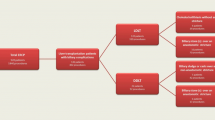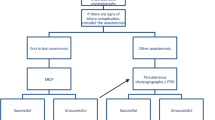Abstract
Background
Liver transplantation has become common in India over the last decade and biliary strictures after the procedure cause a significant morbidity. Endoscopic retrograde cholangiopancreatography (ERCP) is a safe and effective treatment modality for post-transplant biliary strictures so we decided to evaluate prospectively the outcomes of endoscopic treatment in post-living donor liver transplantation (LDLT) biliary strictures.
Methods
We studied ten consecutive patients who had developed biliary strictures (out of 312 who had undergone liver transplantation between June 2009 and June 2013) and had been referred to the Department of Gastroenterology for management. All patients underwent liver function tests, ultrasound of the abdomen, magnetic resonance cholangiography and liver biopsy, if this was indicated.
Results
Of these 312 patients who underwent liver transplantation, 305 had living donors (LDLT) and 7 deceased donors (DDLT). Ten patients in the LDLT group (3.3 %) developed biliary strictures. There were seven males and three females who had median age of 52 years (range 4–60 years). The biliary anastomosis was duct-to-duct in all patients with one patient having an additional duct-to-jejunum anastomosis. The mode of presentation was cholangitis in four patients (40 %), asymptomatic elevation of liver enzymes in four (40 %) and jaundice in two patients (20 %). The median time from transplantation to the detection of the stricture was 12 months (2–42.5 months). ERCP was attempted as initial therapy in all patients: seven were managed entirely by endoscopic therapy, and three required a combined percutaneous and endoscopic approach. Cholangiography demonstrated anastomotic stricture in all patients. A total of 32 sessions of ERCP were done with mean of 3.2 (2–5) endoscopic sessions and 3.4 (1–6) stents required to resolve the stricture. The median time from the first intervention to stricture resolution was 4 months (range 2–12 months). In four patients, the stents were removed after one session and in two patients each after two, three and four sessions. In six patients more than one stent was placed and all of them required dilatation of stricture. Seven patients completed treatment and are off stents at a median follow up period of 9.5 months (7–11 months). Two patients developed recurrence of their stricture after 7.5 months. Both had long strictures and required a combined endoscopic and percutaneous approach. There was one mortality due to sepsis secondary to cholangitis.
Conclusions
Post-LDLT biliary strictures can be successfully treated with ERCP, and most patients remain well on follow up (median 9.5 months). A combined endoscopic and percutaneous approach is useful when ERCP alone fails.




Similar content being viewed by others
References
Thethy S, Thomson BNJ, Pleass H, et al. Management of biliary tract complications after orthotopic liver transplantation. Clin Transpl. 2004;18:647–53.
Hampe T, Dogan A, Encke J, et al. Biliary complications after liver transplantation. Clin Transpl. 2006;20 Suppl 17:93–6.
Gomez CM, Dumonceau JM, Marcolongo M, et al. Endoscopic management of biliary complications after adult living-donor versus deceased donor liver transplantation. Transplantation. 2009;88:1280–5.
Kato H, Kawamoto H, Tsutsumi K, et al. Long-term outcomes of endoscopic management for biliary strictures after living donor liver transplantation with duct-to-duct reconstruction. Transpl Int. 2009;22:914–21.
Kim TH, Lee SK, Han JH, et al. The role of endoscopic retrograde cholangio-pancreatography for biliary stricture after adult living donor liver transplantation: technical aspect and outcome. Scand J Gastroenterol. 2011;46:188–96.
Seo JK, Ryu JK, Lee SH, et al. Endoscopic treatment of biliary stricture after adult living donor liver transplant. Liver Transpl. 2009;15:369–80.
Yazumi S, Yoshimoto T, Hisatsune H, et al. Endoscopic treatment of biliary complications after right-lobe living-donor liver transplantation with duct-to-duct biliary anastomosis. J Hepatobiliary Pancreat Surg. 2006;13:502–10.
Rizk RS, McVicar JP, Emond MJ, et al. Endoscopic management of biliary strictures in liver transplant recipients: effect on patient and graft survival. Gastrointest Endosc. 1998;47:128–35.
Tzakis AG, Gordon RD, Shaw BW Jr, et al. Clinical presentation of hepatic artery thrombosis after liver transplantation in the cyclosporine era. Transplantation. 1985;40:667–71.
Sanchez-Urdazpal L, Gores GJ, Ward EM, et al. Diagnostic features and clinical outcome of ischemic-type biliary complications after liver transplantation. Hepatology. 1993;17:605–9.
Sanna C, Giordanino C, Giono I, et al. Safety and efficacy of endoscopic retrograde cholangiopancreatography in patients with post-liver transplant biliary complications: results of a cohort study with long-term follow-up. Gut Liver. 2011;5:328–34.
Greif F, Bronsther OL, Van Thiel DH, et al. The incidence, timing, and management of biliary tract complications after orthotopic liver transplantation. Ann Surg. 1994;219:40–5.
Soin AS, Kumaran V, Rastogi AN, et al. Evolution of a reliable biliary reconstructive technique in 400 consecutive living donor liver transplants. J Am Coll Surg. 2010;211:24–32.
Kitazono MT, Qayyum A, Yeh BM, Chard PS, Ostroff JW, Coakley FV. Magnetic resonance cholangiography of biliary strictures after liver transplantation: a prospective double-blind study. J Magn Reson Imaging. 2007;25:1168–73.
Chok KS, Chan SC, Cheung TT, et al. Bile duct anastomotic stricture after adult-to-adult right lobe living donor liver transplantation. Liver Transpl. 2011;17:47–52.
Van Thiel DH, Fagiuoli S, Wright HI, Rodriguez-Rilo H, Silverman W. Biliary complications of liver transplantation. Gastrointest Endosc. 1993;39:455–60.
Morelli J, Mulcahy HE, Wilner IR, Cunningham JT, Draganov P. Long-term outcome of patients with post liver transplant anastomotic biliary stricture treated by endoscopic stent placement. Gastrointest Endosc. 2003;58:374–9.
Graziadei IW, Schwaighofer H, Koch R, et al. Long-term outcome of endoscopic treatment of biliary strictures after liver transplantation. Liver Transpl. 2006;12:718–25.
Thuluvath PJ, Atassi T, Lee J. An Endoscopic approach to biliary complication following orthotopic liver transplantation. Liver Int. 2003;23:156–62.
Costamagna G, Pandolfi M, Mutignani M, Spada C, Perri V. Long-term results of endoscopic management of postoperative bile duct strictures with increasing numbers of stents. Gastrointest Endosc. 2001;54:162–8.
Chang JH, Lee IS, Choi JY, et al. Biliary stricture after adult right-lobe living-donor liver transplantation with duct-to-duct anastomosis: long-term outcome and its related factors after endoscopic treatment. Gut Liver. 2010;4:226–33.
Hsieh TH, Mekeel KL, Crowell MD, et al. Endoscopic treatment of anastomotic biliary strictures after living donor liver transplantation: outcomes after maximal stent therapy. Gastrointest Endosc. 2013;77:47–54.
Author information
Authors and Affiliations
Corresponding author
Ethics declarations
Conflict of interest
PR, RKB, NM, SL, VK, MKS, MK, and SN declare that they have no conflict of interest.
Ethics statement
The authors declare that the study was performed in a manner to conform with the Helsinki Declaration of 1975, as revised in 2000 and 2008 concerning Human and Animal Rights, and the authors followed the policy concerning Informed Consent as shown on Springer.com.
Rights and permissions
About this article
Cite this article
Ranjan, P., Bansal, R.K., Mehta, N. et al. Endoscopic management of post-liver transplant billiary complications: A prospective study from tertiary centre in India. Indian J Gastroenterol 35, 48–54 (2016). https://doi.org/10.1007/s12664-016-0625-4
Received:
Accepted:
Published:
Issue Date:
DOI: https://doi.org/10.1007/s12664-016-0625-4




